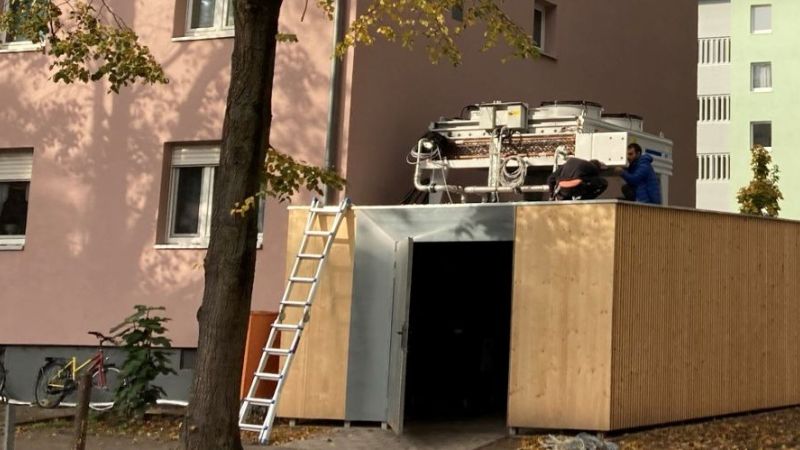 © New Africa - stock.adobe.com
© New Africa - stock.adobe.com
Building refurbishment
Quality assurance for windows and glazing
The developed measuring device in combination with evaluation software enables the actual energy-related properties of windows and facades in existing buildings to be investigated, whereby the connections to the building structure are also taken into account. In addition, a sensor system has been developed that makes it possible to optimise the production process used for manufacturing insulating glazing. A process for improving the quality assurance in the production of insulation glazing has also been developed. An optical measurement process enables very precise measurement of the inert gas fill level in the glazing cavity. The system functions in-line, i.e. during the ongoing production process, and takes just a few seconds. This makes it possible to achieve more reliable manufacturer specifications for the Ug-value.
The existing building stock currently contains more than 300 million windows whose thermal protection quality cannot keep pace with the currently available modern windows developed during the last 20 years. Those replacing windows dating back to before 1995 can therefore achieve considerable benefits in terms of the energy efficiency, comfort and security. Whether it is actually worthwhile refurbishing windows needs to be verified in each individual case. However, that is not actually very easy: whereas the thermal protection factor, i.e. the Ug-value, in newer existing glazing can generally be determined from the manufacturer’s specifications, the thermal value of older thermal insulation glazing is often a matter of conjecture.
It is only possible to determine the actual window quality and whether it makes sense to refurbish the windows from an energy efficiency and economic standpoint by carrying out an on-site analysis.
The software tool enables individual windows or complete building facades to be recorded and assessed in terms of their energy efficiency. It is also intended that the measuring device and software can be deployed by users without any specific expertise in building physics: this should therefore enable specialist designers, appraisal experts and consultants from the window, facade and glazing industries to analyse and assess the window quality for the majority of building types and usages.
Research focus
With the involvement of a research institute, a university and seven companies, the three-year research project is aimed at developing a methodology with which the actual thermal protection quality of windows can be determined with a mobile measuring device and recorded and assessed with a software tool for individual windows or complete facades or buildings.
Mobile measuring device
Even if no glazing data is available, the thermal protection properties of glazing can be determined using Uglass, a compact and mobile measuring device. The device, which consists of two halves, is applied to both sides of the insulation glazing using a suction pump.
The sensor then heats the glazing on one side and measures the increase in temperature ΔT on the other side of the glazing. The course of ΔT over time is analysed and from this the Ug-value of the glazing is derived. This takes place in less than 10 minutes for double-glazed insulation glass units and within 20 minutes for triple-glazed insulation glass units, whereby Ug-values between 0.5 to 4 W/m2K can be reliably determined. The measurement accuracy ranges between ± 10%.
The determined Ug-values are utilised by the assessment software to enable the energy efficiency of the windows to be evaluated in a substantiated manner in the installed context.
Assessment software
Uwin is a software system for estimating the energy saved when refurbishing windows. Based on recognised computational algorithms, it calculates the expected improvement in energy efficiency to be gained by replacing windows or glazing. The specific energy savings potential when replacing windows depends on many underlying conditions: in addition to the building’s location, window orientation, shading and installation situation, the type of building and usage, the age of the building, its state of modernisation and the type of heating also play a role.
With this software, adaptive algorithms also enable assessments to be made even if it is only possible to determine a small amount of data (rough analysis). The more detailed the data input, the greater the preciseness with which the tool calculates the energy losses through the existing window. With a detailed analysis, the energy losses are assessed in a very much more differentiated manner, including the solar thermal gains and the ventilation thermal losses. The Ug-value can also be calculated in accordance with the inclination. Building information, the type of window installation and materials used, the shutter housings, type of glazing and the window dimensions (proportion of frame) are also taken into account and the values are compared with the desired replacement window. This can also be conducted without any specific knowledge of buildings physics or heating technology, i.e. it can be generally carried out by technicians, designers and consultants from the window industry.
Inline quality assurance with insulation glazing
With the newly developed inline quality assurance system, a sensor spot is installed in the glazing cavity during the insulation glazing production process. This enables the inert gas fill level to be very precisely determined during the ongoing production process. If the precise emissivity of the coating (low ε) is also known, it is possible to determine the Ug-value for the glazing. The measurement technology can be automatically incorporated into the production line in an easy and cheap manner and enables seamless quality control. The sensor spot could be supplemented with a transponder as part of a further development stage. This would then enable all product data such as the structure, gas fill level, Ug-value, etc., to be stored by the manufacturer in order to document it for further use.










